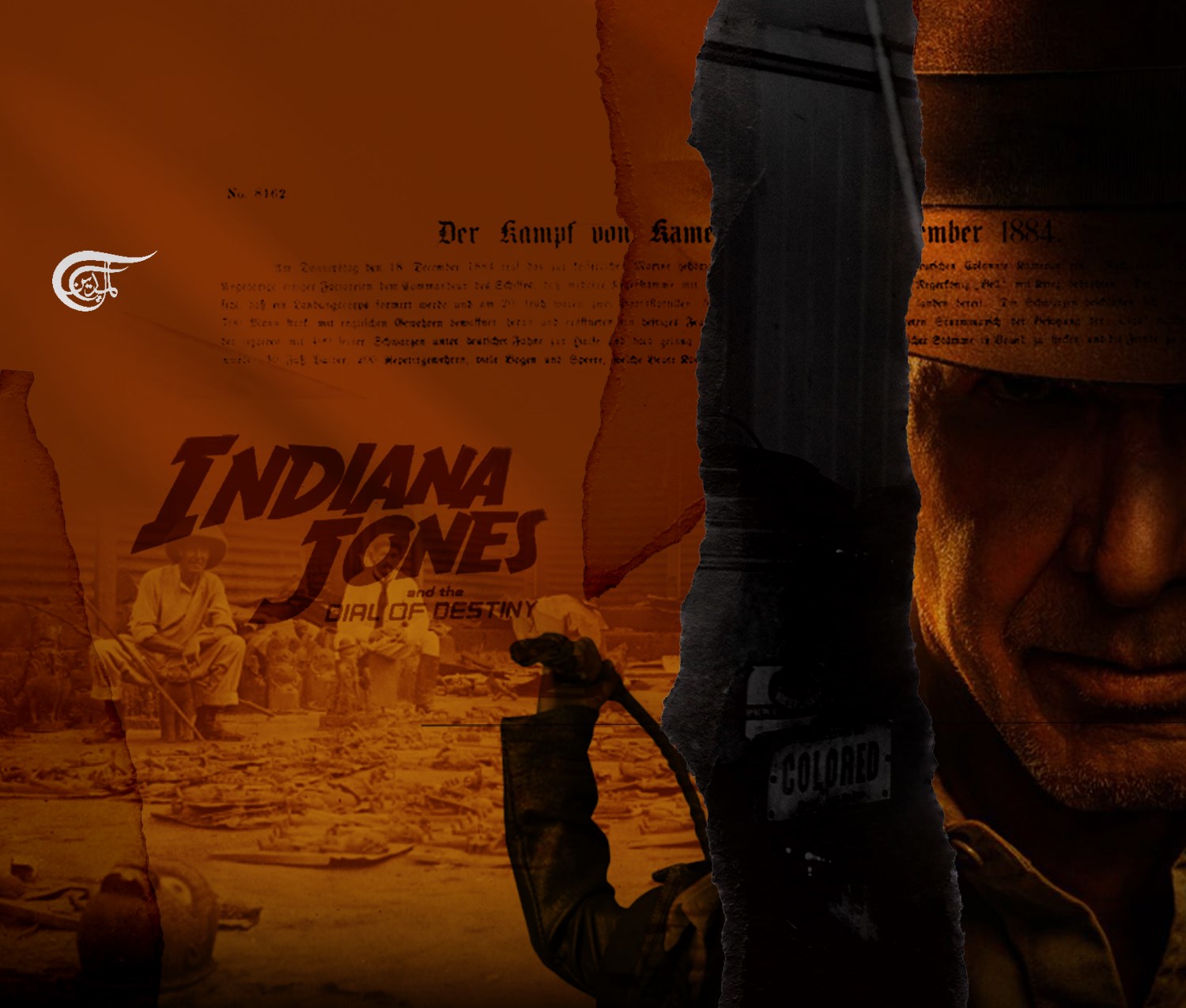Indiana Jones, Hollywood’s chief colonial pilferer, is back
If the official trailer is any indication, “mistakes” of the past regarding the depiction of other cultures (Euro-Western supremacy’s gaffes are all too often by design) will be repeated.
In his 2019 book Who Owns History? Elgin’s Loot and the Case for Returning Plundered Treasure, human rights lawyer Geoffrey Robertson QC outs the prestigious British Museum as “the world’s largest receiver of stolen property," accusing Western “encyclopedic museums” in London, Paris, or New York of “lock[ing] up the precious legacy of other lands, stolen from their people by wars of aggression, theft, and duplicity.”
Four years later, Hollywood’s chief colonial plunderer and academic imperialist, the (in)famous fedora-wearing and whip-wielding Indiana Jones (played by Harrison Ford), is set to come out of retirement for one last heist, once again attempting to steal a cultural artifact that does not belong to him (or his culture, for that matter).
After looting the biblical Ark of the Covenant in Raiders of the Lost Ark (1981), stealing Hindu religious stones in the prequel Indiana Jones and the Temple of Doom (1984), violating the sanctity of the fabled Holy Grail in Indiana Jones and the Last Crusade (1989), and hunting down a Mesoamerican artifact in Indiana Jones and the Kingdom of the Crystal Skull (2008), the final installment of an action-adventure franchise and its equally adventurous marriage of fact and fiction, not to mention its notoriety for glorifying colonial thievery and its racist depictions of Brown people and the Global South, promises to be yet another delightful guilty pleasure.
Not much is known about Indiana Jones and the Dial of Destiny (the first movie of the franchise not directed by Steven Spielberg), which will premier at this year’s Cannes Film Festival and will see the archeology professor who moonlights in legalized master thievery for the organized crime syndicates that are Western museums of human history and culture and the US military beat his Nazi and Russian nemeses in finding yet another prized relic.
But if the official trailer is any indication, “mistakes” of the past regarding the depiction of other cultures (Euro-Western supremacy’s gaffes are all too often by design) will be repeated.
“I’ve been tortured with voodoo,” brags Indy to his goddaughter (played by Fleabag actress Phoebe Waller-Bridge) in one of the scenes, who in another casually defends the act of stealing the movie's eponymous artifact by saying, “It’s called capitalism," inadvertently admitting to the entrenched nexus between the latter and European colonialism.
Indy’s quote alludes to the Temple of Doom movie in which the villain has made a “voodoo” doll of him. One would think that an esteemed orientalist like Dr. Jones should know better than to use a term appropriated by Western pop culture which, due to exclusively negative media portrayals depicting a menacing religion mired in satanism and witchcraft, has loaded it with anti-Black racism.
All of which has little to do with actual syncretic Afro-Caribbean belief systems such as Haitian Voudou, which scholars have described as “one of the most maligned and misunderstood religions," or its descendent, Louisiana Voodoo. Furthermore, none of the aforementioned features effigies that are pinpricked for sadistic pleasure, and it does not help that the Disney corporation which owns the Indiana Jones franchise perpetuates this ahistorical trope by continuing to sell a replica of the Indy voodoo doll (including pin!) for a whopping 130 US dollars (it’s called capitalism, they will argue) in their online store.
Having a white actor play a Brown character in the 2020s, namely John Rhys-Davis in the role of Sallah, the trusty oriental, is another hopelessly outdated racist continuity. Remember that this guy’s sole raison d’être is to be at his white “friend’s” (can unequal, racialized power relationships even be called friendships?) constant beck and call whenever the latter who, as a Westerner, has the ill-gotten socio-economic privilege to globetrot, happens to be in the neighborhood.
Last, but probably not least, there is the franchise’s signature exoticization of the Global South and its singular function as a playground for the reckless self-actualization of white privilege (as evidenced by the clichéd car chase scene of a fleeing Indy in a hijacked auto rickshaw).
From the outset, the Indiana Jones movies have been highly problematic (code for deeply racist). The iconic temple run scene of Raiders is a case in point: after botching the theft of a fertility idol, a fleeing Indy is pursued through the Peruvian jungle by an angry mob of near-naked “natives” brandishing bows and arrows, only managing to escape thanks to a waiting seaplane on the river, while his pursuers (who Spielberg’s colonial gaze portrays as being scared of water, even though it is part of their natural habitat) are left to wallow in their defeat.
Not only does this scene glorify colonial theft, but it also ridicules Indigenous resistance to it and perpetuates the dichotomous trope of Euro-Western technological advancement and Indigenous archaism and helplessness. The story that this scene does not tell is how the West’s technological superiority was only made possible through the forced labor of colonized peoples and the violent plunder of their resources that propelled Europe’s Industrial Revolution.
Then there is that early flashback scene in Last Crusade: a teenage Indy discovers a group of robbers who find a crucifix belonging to the conquistador Francisco Vásquez de Coronado (to this day, much of mainstream Western historiography continues to refer to these barbaric Iberian colonizers as benevolent “explorers”) during a boy scout outing in Utah. Passionately arguing that it belongs in a museum, Indy successfully steals the artifact, only to have it taken from him by the town sheriff who is in cahoots with the robbers.
The fact that white thief A is arguing with white thief B about a religious symbol belonging to white thief C that is intrinsically tied to the violent plunder of the Americas and wishes to hand it over to white thief D, a Western museum, and that this argument is happening on land conquered by illegal European settlers in what effectively was the largest and deadliest home invasion in modern human history, says everything there is to know about the entitled and intransigent mindset that made European colonialism possible in the first place.
The glorification of colonial theft is not the only thing wrong with the Indiana Jones franchise: its representation of people of color and the Global South has been equally hard to stomach: Who will forget the infamous Temple of Doom, one of Hollywood's most unapologetic cinematic insults to South Asians, a movie so racist even by 1980s standards that Spielberg was denied permission to shoot in India, which also banned the film upon release.
“It’s not hard to see why local censors were horrified at a movie set in colonial-era India that stereotyped nearly every single character who had the misfortune of having brown skin,” writes the film editor of digital news publication Scroll.in.
Among those is the principal villain, the Thugee cult leader Mola Ram (played by Amrish Puri), who extracts beating hearts from his victims, engages in human sacrifices and oversees a child slavery ring. The desperate Indian villagers who - quelle surprise - have no agency of their own beseech Indy to liberate them from Ram’s tyranny, thus elevating the archeologist-adventurer to white savior.
And who will forget the notorious dinner scene where Indians are portrayed as savages who eat spiders, snakes, and monkey-brain soup?
The only other type of Brown supporting role allowed to exist next to the evil villain is the sidekick serving the white hero savior, embodied by the character of Short Round, a scrappy pidgin English-speaking orphan kidnapped off the streets of colonial Shanghai. He was played by Ke Huy Quan who won this year’s Oscar in the category Best Supporting Actor for Everything Everywhere All at Once, lauded as a milestone of Asian-American on- and off-screen equity.
But only a year after Temple of Doom, the South Vietnamese-born actor would reprise his demeaning role of racialized human sidecar created exclusively for white amusement in the adventure cult classic The Goonies, this time as a gadget-tinkering, geeky token diversity hire named Data (an early example of Hollywood’s equally harmful positive racism and the racial stereotype of Asians being good at science) in an otherwise all-white group of suburban white kids.
Kingdom of the Crystal Skull was released in the same year the US elected its first Black president. Yet, the 19-year time gap to Last Crusade was apparently not long enough to incorporate some of the paradigm-shifting societal progress happening in the real world: Hollywood’s continued negative representation of Latin America, which the domineering US has historically and pejoratively viewed as its “backyard”, understandably drew the ire of Peruvian and Mexican moviegoers alike.
It will be interesting to see if in 2023, in the midst of an era of decolonizing history, culture, and mindsets, the final installment of an entertaining, yet problematic media franchise will adapt to the current Zeitgeist by decolonizing its own storytelling, or go down in cinematic history as a stubborn anachronism to be pitied.

 Timo Al-Farooq
Timo Al-Farooq
 9 Min Read
9 Min Read











